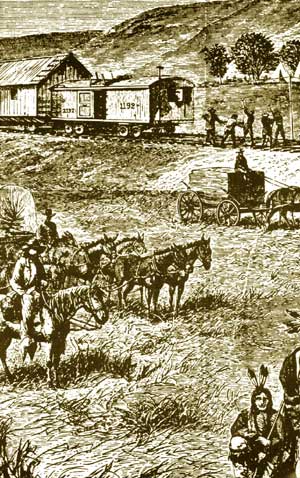|
GOLDEN SPIKE National Historic Site |
 |
With blare of bands the work began,
Long speeches stirred the crowd.
But lack of three things prevented speed;
No men, no iron, no gold.
War was till upon the land,
Hungry for the three.
Progress was slow, or not at all;
The railroad could not move.
Congress acted to help the road,
Made possible its building.
The means were soon to be at hand,
The race would soon begin.
The Railroad Act of 1864
Impressive ceremonies—more impressive than those 6 years later at the driving of the last spike—launched the two railroads. The Central Pacific broke ground at Sacramento on January 8, 1863, the Union Pacific at Omaha on December 2, 1863.
Neither road made much progress. The war sent the price of materials soaring and made labor extremely scarce. Capital could not be enlisted, for war prosperity afforded better investment opportunities than in a railroad whose first dividend lay far in the future. In California the Central Pacific found itself bitterly opposed by a powerful alliance of stage, ship, freight, and telegraph companies that fought with every weapon at its command. As California's Republican war Governor, however, Leland Stanford managed to bring some State financial aid to his company. With this, and by borrowing on their personal security, the four associates pushed their rails 18 miles east of Sacramento by February 1864. But the Union Pacific did not even lay its first rail until the spring of 1 865. The railroad builders, facing ruin, turned again to Congress with quite valid reasons for more Government help. The Railroad Act of 1864 was the result.
Signed by the President on July 2, 1864, this act doubled the resources made available to the railroad by the parent legislation. Although reducing the right-of-way from 400 to 200 feet, the 1864 Act doubled the land grant. The companies were now to receive 20 sections of land per mile—10 alternate sections on each side of the track. Of more immediate benefit, the Government relinquished its first lien on the railroad by authorizing the companies, as they received Government subsidy bonds, to issue equal amounts of their own 6-percent, 30-year bonds. The company bonds were now to constitute a first mortgage on the road, the U.S. bonds a second mortgage on the road. In addition to these major concessions, the act contained a number of minor liberalities that made compliance with Government regulations far easier than before.

National Archives
The act limited the Central Pacific to building no more than 150 miles east of the California-Nevada boundary. Of this provision, Collis P. Huntington later wrote: "150 miles ought not to have gone into the bill; but I said to Mr. Union Pacific, when I saw it, I would take that out as soon as I wanted it out." When he did, 2 years later, he fired the starting gun for the great railroad race.
The 1864 Act made the United States "virtually an endorser of the company's bonds for the full amount of its own subsidy," and now both the U.P. and the C.P. could draw on double the amount of subsidy granted for each mile of completed road. "The financial problem has been solved," rejoiced Stanford in July 1865, "and the result is abundant financial means to press forward the work to its utmost development." To abundant finances, the end of the Civil War added abundant labor and material. The two companies marshalled forces for a 10—year job that would take less than 4 years.

|
|
Last Modified: Sat, Sep 28 2002 10:00:00 pm PDT |


